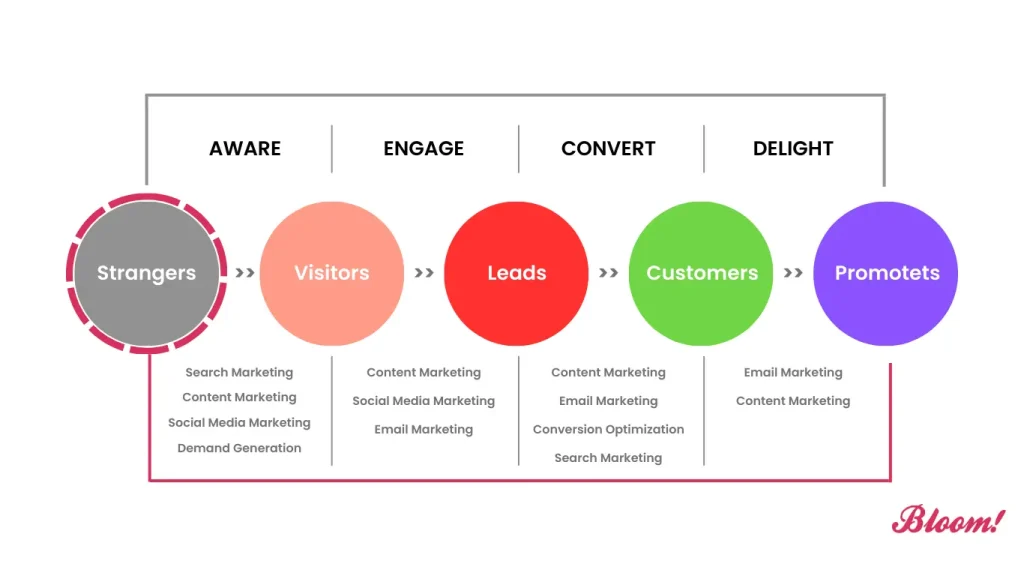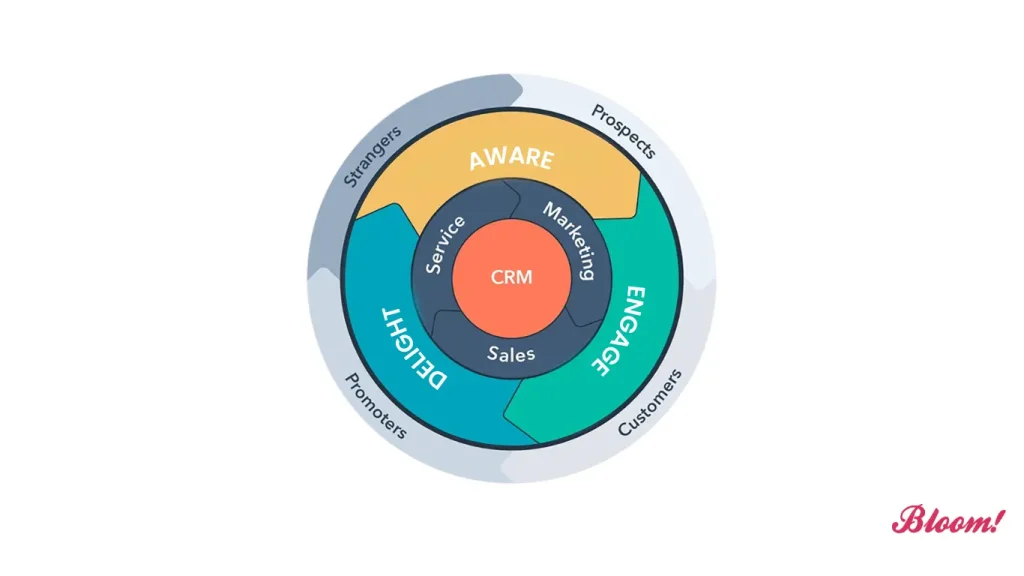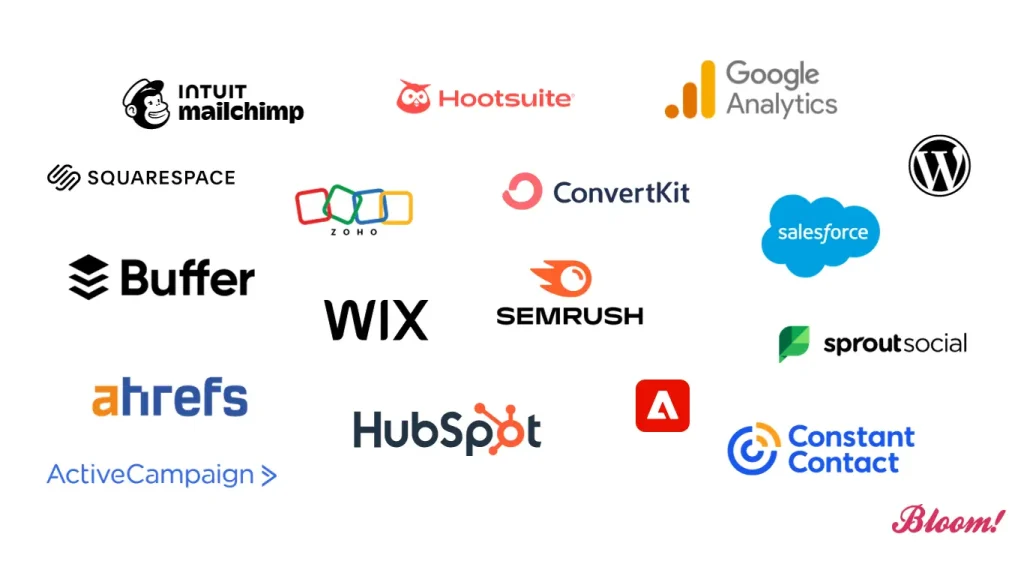Highlights
- Inbound Marketing, contrasting with traditional marketing, centers on attracting customers with valuable, relevant content tailored to their interests, aiming to establish genuine connections and narrate a brand’s story that resonates with the audience.
- It’s a cost-effective strategy that builds trust and nurtures long-term customer relationships, promoting sustainable growth. Its adaptability allows customization to meet distinct business needs and target audience preferences.
- The Aware, Engage, and Delight approach unfolds in three stages: attracting the right audience, meaningful engagement, and ensuring satisfaction to transform them into brand advocates. This aligns well with the Flywheel Model, symbolizing how positive interactions fuel business growth.
Introduction
In the dynamic landscape of modern business, standing out from the noise and reaching your target audience can be challenging. Enter a strategy that pivots towards the customer’s perspective, offering a significant shift in how businesses approach their audience. Yet, the question remains: what is this strategy, and why must business owners take note?
Inbound Marketing Definition
Inbound marketing is not just another marketing buzzword; it’s a philosophy that places your audience at the heart of your strategy. In contrast to the disruptive tactics of outbound marketing, this modern strategy welcomes potential customers with engaging and valuable content designed specifically for them.
In contrast to the disruptive tactics of traditional marketing, this customer-focused strategy draws in potential clients by offering valuable and pertinent content that caters to their specific desires and questions.
At its core, this approach is about creating an experience that resonates with the customer, allowing businesses to naturally draw in prospects with an approach that is both helpful and unobtrusive. It encompasses a variety of tactics, including creating engaging content, optimizing for search engines, and managing a social media presence. This strategy is informed by comprehensive, data-driven insights and leverages a rich array of digital content to captivate and connect with a well-defined audience.
What are the benefits of Inbound Marketing for Businesses?
Inbound marketing provides many advantages, especially for small businesses that may lack the extensive resources of larger companies. They can make informed decisions and effectively use inbound strategies by comprehending these benefits.
- Cost-Effective. This approach is renowned for its exceptional cost-effectiveness compared to traditional marketing methods. Businesses can effortlessly create and share content, optimize their websites for search engines, and engage with audiences on social media without straining their finances. For instance, maintaining a blog is minimal compared to the substantial costs incurred by traditional advertising channels like TV, radio, or ads. Furthermore, strategic inbound marketing ensures organic growth through improved search engine results and positive word-of-mouth, diminishing reliance on paid advertising.
- Targeted. This customer-centric marketing method enables businesses to target potential customers more effectively. Companies can use SEO and content creation centered around specific topics to attract a highly qualified audience actively seeking related information. Unlike traditional marketing, which casts a wider net and may not reach individuals with a genuine interest or need for the product or service, inbound marketing connects directly with individuals already in the market for what you’re offering. This targeted approach significantly increases the chances of converting prospects into customers.
- Build Long-Term Relationships. This value-driven approach is all about delivering value to customers before they purchase. This value-based approach builds the foundation for long-term relationships and nurtures brand loyalty. Small businesses can cultivate a dedicated customer base by consistently providing helpful content, support, and engagement. Unlike traditional marketing methods that merely secure one-time sales, inbound marketing aims to foster relationships where customers become repeat buyers and enthusiastic brand advocates.
- Measurable. This data-centric marketing approach is highly measurable, so you can see what works and adjust your strategies accordingly. Using various analytics tools, small businesses can track website traffic, conversion rates, social media engagement, and email campaign performance. This data-driven approach is less prevalent in traditional marketing, where linking specific efforts to outcomes can be challenging. Inbound marketing metrics allow for optimizing campaigns and strategies, ensuring that resources are used efficiently and effectively.
- Adaptive. It can be tailored to suit your unique business needs and target audience. Inbound marketing can be customized for success, whether you operate in a niche market or a competitive industry.
By embracing inbound marketing, businesses can create meaningful customer interactions, foster loyalty, and build a sustainable pipeline for leads and sales. In the digital age, where consumers are flooded with information, inbound marketing helps businesses connect with consumers more organically and humanely.
Inbound Marketing Meaning: A Relationship-Centric Approach
Inbound marketing transforms how businesses interact with their audiences by aligning marketing activities with customer behavior and preferences. It’s a customer-centric approach that moves away from interruptive tactics and instead focuses on pulling customers in with compelling content. Here’s how it works in stages:
1. Aware: Drawing in the Right Audience.
The initial stage of the inbound methodology focuses on building awareness. Potential customers actively seek information, often without knowing your product or service or its potential to address their needs. The objective is to establish your presence by delivering informative content on platforms where your target audience already seeks information.
Here are some key strategies:
- Content Creation. Develop high-quality, informative, and valuable content that addresses your target audience’s pain points and interests. This content includes blog posts, articles, videos, infographics, and more.
- Search Engine Optimization (SEO). Optimize your online content to make it more discoverable by search engines. This involves using relevant keywords and meta descriptions and optimizing the website structure.
- Social Media Engagement. Use social media platforms to share your content and engage with your audience. It’s a space to foster conversations and connect with potential customers.
2. Engage: Building Relationships Through Value.
Once you’ve captured your audience’s attention, the next step is to engage with them. Your content should not only inform but also inspire interaction. This can be achieved through interactive content like quizzes, webinars, or engaging videos. Social media is crucial here, providing a platform for conversations and community-building. During this stage, learning more about your prospects’ challenges and needs is vital, which can inform you how you guide them to the next step.
3. Convert: Where an Engaged Audience is Transformed Into Valuable Leads.
Conversion is pivotal in the inbound methodology, transforming an engaged audience into valuable leads. This transformation is typically supported by presenting something useful, such as an ebook, a free trial, or a consultation in exchange. Balance is paramount at this stage – offering enough value to entice prospects to share their information while maintaining the intrigue around your product or service. Empower your conversion journey with the essential tools of landing pages, forms, and compelling calls-to-action (CTAs).
4. Delight: Ensuring Customer Satisfaction.
The delight stage is all about providing an exceptional experience to your customers. It’s not sufficient to merely convert leads; you must guarantee their satisfaction and support after they’ve made a purchase. By delighting customers, you transform them into loyal repeat buyers and amplify the likelihood of them advocating for your brand to others.
Here’s how to ensure delight:
- Exceptional Customer Service. Go the extra mile to provide excellent customer service. Be responsive, promptly address concerns, and ensure your customers feel valued.
- Continuous Value. Continue delivering value even after the sale. Share educational content, offer exclusive deals, and provide ongoing support.
- Feedback and Improvement. Listen to customer feedback and use it to improve your products or services. Show that you’re committed to meeting their evolving needs.
5. Loyalty Loop
Once you’ve successfully delighted your customers, it’s time to dive into the loyalty loop. This crucial phase is all about nurturing relationships to foster loyalty. The goal is to create a cycle where customers return for more and become true brand ambassadors. Loyalty can be cultivated through loyalty programs, exclusive offers, and actively seeking and valuing customer feedback. By showing customers their opinions are valued and acted upon, you can strengthen their loyalty and propel your brand to new heights.
6. Advocacy
The final stage is advocacy, where delighted customers become the brand’s greatest advocates. Please encourage them to share their positive experiences with their networks through referral programs, engaging with customers online, or featuring customer testimonials. These advocates enhance your marketing efforts by providing credible, trusted business endorsements.
The inbound methodology is not a linear process but a continuous loop. Each stage seamlessly feeds into the next, creating a sustainable system that can adapt and grow with your business. In the following sections, we will explore how to leverage each stage to maximize the effectiveness of inbound marketing for small businesses.
Understanding the Flywheel
Imagine a giant, perfectly balanced wheel—a flywheel—representing your business. This wheel can gain momentum with every interaction and turn of your marketing efforts. It’s driven not only by acquiring new customers but by the energy created when customers have a positive experience and become advocates for your brand.
Now, you might wonder how the Flywheel Model relates to inbound marketing. The constructive collaboration between the two is profound. Marketing strategies, like creating valuable content, engaging with your audience, and delivering exceptional experiences, align seamlessly with the principles of the Flywheel Model.
Attracting New Prospects
Inbound marketing’s focus on creating valuable content and addressing customer pain points naturally attracts new prospects to your business. This initial momentum starts the flywheel spinning.
Engaging and Delighting
The engagement and delight stages of inbound marketing correspond directly to the Flywheel Model. Engaging your prospects and customers with personalized content and solutions keeps the wheel turning while delighting them and ensures they become loyal advocates who promote your brand.
Advocacy and Growth
As your customers become advocates, they amplify your brand’s reach. Their referrals and positive word-of-mouth recommendations attract new prospects to your business, further powering the Flywheel and driving growth.
The Role of Businesses
You might think, “This all sounds great, but how does it apply to my business?” The Flywheel Model is scalable and adaptable, making it just as relevant for small businesses as it is for large corporations.
Businesses can use inbound strategies and tools to create a positive feedback loop within their flywheels. Here’s how:
- Content Creation. Develop valuable content that resonates with your audience’s needs and interests. This content serves as the initial force needed to start your flywheel spinning.
- Engagement. Engage with your audience through social media, email marketing, and personalized interactions. This keeps the momentum going as prospects become customers.
- Exceptional Customer Experiences. Ensure every interaction with your business is delightful. This transforms customers into brand advocates who fuel your growth.
Measuring Success
One of the beauties of the Flywheel Model is that it’s not just a theoretical concept—it’s highly measurable. Business owners can track metrics like customer retention, referral rates, and customer base growth to gauge their flywheels’ effectiveness.
In conclusion, when powered by inbound marketing strategies, the Flywheel Model offers businesses a blueprint for sustainable growth. It’s a shift from the traditional one-way funnel to a dynamic, continuous cycle of attracting, engaging, and delighting customers. By understanding and implementing this model, business owners can harness its potential to drive success, foster brand advocates, and keep the Flywheel of growth spinning.
Key Components of Inbound Marketing Strategy
- Content Marketing is the bedrock of attracting and captivating your audience, delivering valuable and pertinent content that resonates deeply with their needs and interests. Detailed Article: Inbound Strategy Components – Content Marketing
- SEO is crucial in boosting your online footprint and pulling in organic traffic by fine-tuning your content with well-researched keywords and establishing a credible presence through both on-page and off-page optimization techniques. Detailed Article: Inbound Strategy Components – SEO
- Landing Page Optimization is vital to crafting a user experience that communicates value and drives visitor action, leveraging precise messaging and thoughtful design to transform interest into leads. Detailed Article: Inbound Strategy Components – Landing Page Optimization
- Email Marketing is essential for cultivating relationships with prospects by delivering customized content that connects with recipients personally, building a bridge between businesses and their clientele. Detailed Article: Inbound Strategy Components – Email Marketing
- Social Media Marketing expands your reach by engaging with a diverse audience across social networks, building a sense of community, and elevating your brand’s visibility where your potential customers are most active. Detailed Article: Inbound Strategy Components – Social Media Marketing
How to create an Inbound Marketing Strategy?
- Defining your target audience is crucial in ensuring your marketing efforts are tailored to the specific needs, behaviors, and preferences of the group most likely to engage with your brand.
- Setting clear goals and objectives is essential for steering your marketing initiatives toward measurable success and ensuring alignment with your business’s overarching vision.
- Establishing a content planning and calendar system is vital for organizing and scheduling your content production, ensuring a consistent and strategic release of material to your audience.
- Designing effective landing pages involves creating a focused and user-friendly interface that communicates value and encourages visitors to act.
- Crafting valuable content is a practical strategy that hinges on delivering insightful and engaging information that resonates with your audience and establishes your brand as a thought leader in your niche.
- Optimizing your website for search engines is a strategic move to increase your online visibility and ensure your site ranks prominently for relevant queries.
- Leveraging social media platforms is about harnessing the power of these networks to connect with your audience, enhance brand recognition, and promote user interaction and content sharing.
- Building email lists and implementing targeted email campaigns are key strategies for directly reaching and engaging your audience to foster loyalty and drive conversions.
Inbound Marketing Tools for Digital Strategies
Now that we’ve explored the principles of inbound marketing and the synergy it shares with the Flywheel Model, it’s time to delve into the practical side. You’ll need the right tools to execute your inbound marketing strategy and power your business’s Flywheel.
Content Management Systems (CMS)
A robust Content Management System (CMS) is the backbone of your content-driven inbound marketing strategy. Businesses can choose from user-friendly CMS platforms like WordPress, Wix, or Squarespace. These platforms simplify content creation, publishing, and management, even for those without technical expertise.
With a CMS, you can effortlessly craft and optimize blog posts, articles, videos, and other content formats that resonate with your target audience. It’s a critical tool for attracting prospects through valuable content.
Search Engine Optimization (SEO) Tools
For businesses, visibility in search engines is paramount. SEO tools like Moz, SEMrush, or Ahrefs can be your best allies in optimizing your website and content for search engines. These tools provide insights into keyword research, on-page SEO recommendations, and competitor analysis.
By implementing SEO strategies, you can improve your website’s ranking in search results, making it easier for potential customers to discover your business when they search for relevant keywords.
Social Media Management Tools
Social media is pivotal in engaging your audience and sharing your content. Tools like Hootsuite, Buffer, or Sprout Social simplify social media management by allowing you to schedule posts, track engagement metrics, and manage multiple social platforms from a single dashboard.
These tools streamline social media marketing efforts for business owners, ensuring consistent and engaging communication with your audience.
Email Marketing Platforms
Email remains one of the most effective ways to nurture leads and engage with customers. Email marketing platforms like Mailchimp, Constant Contact, or ConvertKit enable businesses to create and automate email campaigns.
These platforms provide templates, list management, and analytics to help you send targeted messages that resonate with your audience, whether welcoming new subscribers, sharing valuable content, or promoting exclusive offers.
Customer Relationship Management (CRM) Software
A CRM system like HubSpot CRM, Salesforce, or Zoho CRM is invaluable to engage and delight your customers effectively. CRMs help businesses manage customer interactions, track leads, and tailor their marketing efforts based on customer behavior.
By utilizing CRM, you can create a personalized experience for your customers, ensuring they receive the right messages at the right time.
Analytics Tools
Measuring the effectiveness of your inbound marketing efforts is crucial. Tools like Google Analytics and HubSpot Analytics provide insights into website traffic, conversion rates, and user behavior. These analytics tools help business owners refine their strategies and make data-driven decisions for continuous improvement.
Marketing Automation Software
Marketing automation platforms such as HubSpot Marketing, Marketo, or ActiveCampaign allow businesses to automate repetitive marketing tasks like email sends, lead nurturing, and personalized messaging. This saves time and ensures consistent and timely communication with your audience.
In conclusion, the right inbound marketing tools empower businesses to execute their strategies efficiently, attract prospects, engage with their audience, and foster long-lasting relationships. When used effectively, these tools align with the principles of inbound marketing and the Flywheel Model, propelling your business toward sustainable growth.
Main Challenges in Inbound Marketing
- Building brand awareness is a key challenge, demanding creative and persistent efforts to ensure your brand stands out and resonates with your desired audience. Detailed Article: Inbound Marketing Challenges and How to Overcome Them – Building Brand Awareness
- Generating quality leads presents a challenge, requiring a strategic approach to attract and capture the interest of prospects most likely to become valued customers. Detailed Article: Inbound Marketing Challenges and How to Overcome Them – Low Lead Quality
- Transforming leads into customers is a pivotal challenge, calling for engaging dialogue and trust cultivation to guide potential clients to purchase. Detailed Article: Inbound Marketing Challenges and How to Overcome Them – Converting Leads to Customers
- Retaining and delighting customers is a challenge that involves consistently exceeding expectations and providing exceptional value to encourage repeat business and referrals. Detailed Article: Inbound Marketing Challenges and How to Overcome Them – Retaining and Delighting Customers
- Accurately assessing the effectiveness of marketing activities in terms of financial returns and overall impact on business growth presents a complex challenge in measuring ROI.
Conclusion
Inbound marketing isn’t just a strategy; it’s a philosophy that can transform how businesses approach their marketing efforts. By focusing on building relationships, providing value, and delivering exceptional experiences, inbound marketing offers a path to sustainable growth and customer loyalty.
As a business owner, embracing inbound marketing means understanding the inbound methodology, adopting the Flywheel Model, and utilizing the right inbound marketing tools. It’s about crafting a narrative that resonates with your audience, drawing them in, engaging them, and delighting them. Inbound marketing empowers businesses to create a community of loyal customers who stay and bring in new prospects through advocacy.
So, if you’re a business owner looking to thrive in the digital age, consider the power of inbound marketing. It’s not just a trend; it’s a fundamental shift in how you connect with your audience and drive growth.
Enhancing the customer value journey is pivotal, and this is where specialized inbound marketing services come into play. Tailored to each stage of the journey, these services ensure a deeper connection with your audience and drive effective business growth.
Choosing the right inbound marketing agency can significantly enhance your business. An adept agency navigates through the stages of attracting, engaging, and delighting customers, embodying the essence of inbound marketing. With their expertise, creating resonating content and fostering genuine relationships with your audience becomes a seamless process.
Start your journey into inbound marketing today and watch your business flourish in the world of genuine connections and lasting relationships.
FAQ
- How can one Define Inbound Marketing? Inbound Marketing is a strategy that focuses on attracting customers through valuable, relevant content, aiming to establish genuine connections and effectively narrate a brand’s story.
- Inbound vs Outbound Marketing: What’s the Difference? Inbound Marketing attracts customers through content and engagement, while Outbound Marketing involves pushing messages out to a broad audience using traditional advertising methods.
- Can you provide examples of Inbound Marketing? Examples include developing an extensive knowledge base or resource center that addresses complex industry-specific queries, implementing AI-driven chatbots for personalized user engagement, and creating detailed case studies or whitepapers demonstrating expertise in a particular field. Another example is interactive content like industry-specific tools or calculators that provide value and engage users uniquely and meaningfully.
- How does B2B Inbound Marketing work? B2B Inbound Marketing might involve creating in-depth industry reports and analytical whitepapers that cater to specific business needs, hosting webinars with industry experts to discuss pressing issues, and leveraging account-based marketing strategies to deliver personalized content to key decision-makers. This approach often includes utilizing data-driven insights to tailor content and strategy for different segments of the B2B market, ensuring that the information is relevant and actionable for businesses looking to solve complex challenges.
- How can I make sure that my Inbound Marketing is efficient? Unsure about your Inbound Marketing’s efficiency? We offer targeted digital marketing consulting and digital marketing audit services to improve strategies and achieve goals, or you can read our article How to Conduct a Digital Marketing Audit to Grow Your Business in 2024 for a DIY approach.




